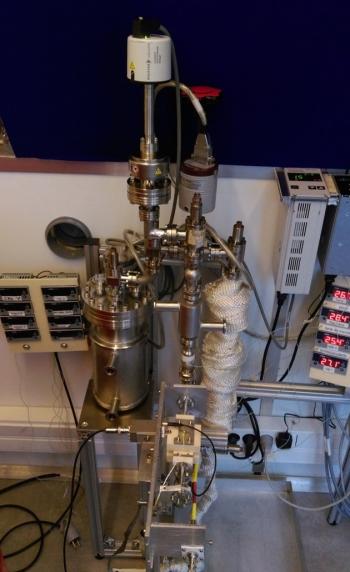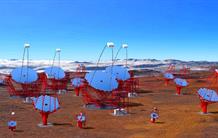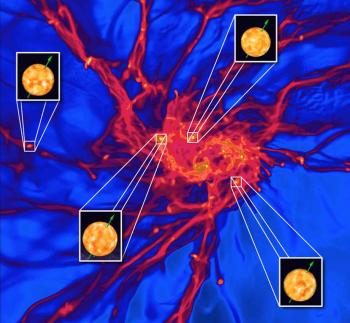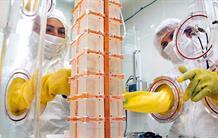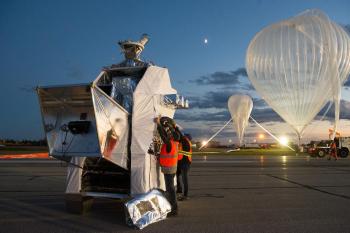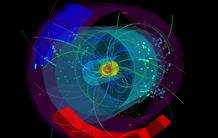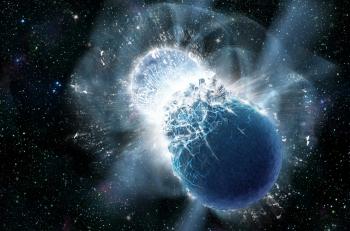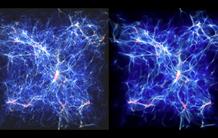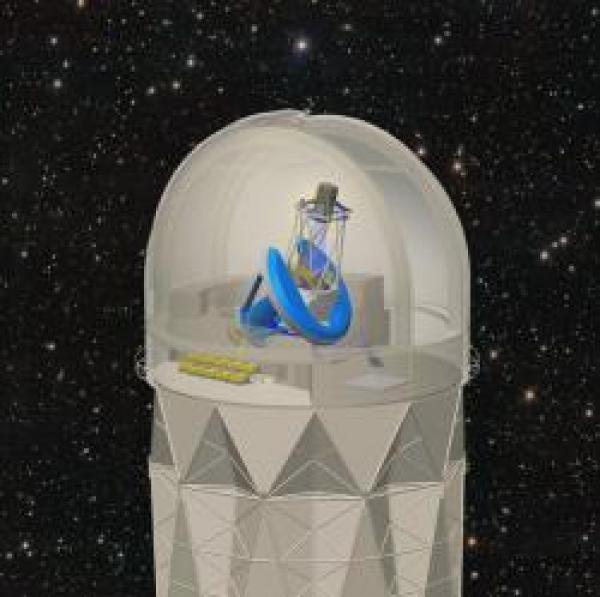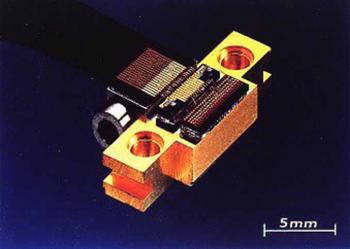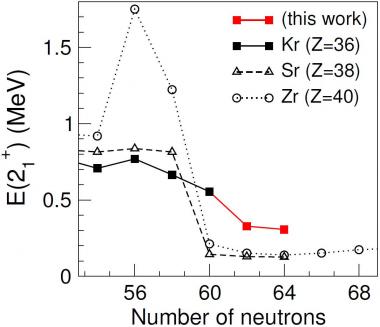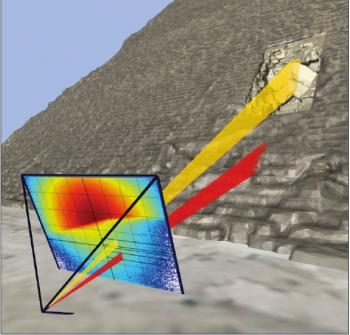In the field of medical imaging, a IRFU team has launched a challenge: their goal is to image the brain activity with a precision of 1 mm3. Its name: CaLIPSO. The idea consists in an innovative detector technology: both light and ionisation signals produced by particle interactions are detected. For this, a series of technological obstacles must be overcome. One of these crucial steps has just succeeded. It consists in implementing the entire chain of ultra-purification of the detection liquid.
The Cherenkov Telescope Array (CTA) consortium brings together 1300 scientists from 32 countries. They have published their scientific aims in a document over 200 pages long. This is the result of several years of work, and includes contributions from approximately fifteen Irfu researchers involved in X-ray and gamma-ray observatories (Fermi, Integral, XMM-Newton, H.E.S.S., etc.).
For more than 10 years now, Irfu physicists and engineers have been developing in Saclay the necessary equipment for the GBAR experiment, designed to test the behaviour of antimatter under terrestrial gravity. An important step has just been taken with the installation at the Cern of a new positron source using on an electron linac, and the transport to the Cern of the positron trapping system built at Saclay.
The new source produced its first positrons on November 17, 2017. The installation of the traps is in progress, to be operational when the antiprotons arrive, scheduled for spring 2018.
The stars do not play dice! It is the extraordinary discovery that the researchers of the Department of Astrophysics-Laboratoire AIM of the CEA-Irfu made by succeeding in determining the orientation in the space of the axis of rotation of stars belonging to two clusters of stars, thanks to asteroseismology. About 70% of the observed stars have perfectly aligned axes of rotation, in formal contradiction with the star formation models which predict that these axes of rotation should be randomly distributed. Numerical simulations showed that, most likely, these stars had managed to retain the initial rotational motion of a cloud that gave rise to the cluster. This discovery, if confirmed in other clusters, could lead to reconsideration of the fundamental processes of star formation. These works make headlines in the journal Nature Astronomy of March 13, 2017
Watch the author's interview : The mysterious alignment of the rotation axis of stars
The mysterious alignment of the rotation axis of stars 
After four years of study, the Luminescent Underground Molybdenum Investigation for Neutrino mass and nature (LUMINEU) collaboration has selected lithium molybdate for the manufacture of scintillating bolometers. These ultrasensitive particle detectors will be used for neutrinoless double-beta-decay searches. Should evidence of the latter be highlighted, neutrinos would merge with their antiparticle and the absolute mass of the neutrino would become accessible.
The PILOT astrophysics experiment has been launched the 17th April under a stratospheric balloon from Alice Springs in central Australia. The aim is to observe the polarization of the emission of dust particles present in the interstellar medium of our Galaxy and the nearby galaxies. With a mass of nearly one ton, PILOT [1] uses the biggest balloons launched by the National Center for Space Studies (CNES). It was developed by the Institute for Research in Astrophysics and Planetology (CNRS / CNES / Paul Sabatier University) and the Institute of Space Astrophysics (CNRS / Université Paris-Sud) and the Institute of Research into the Fundamental Laws of the Universe (CEA-Irfu). Detectors capable of detecting infrared radiation from dust have been developed at the CEA and are the result of research done to realize the PACS camera that equiped the Herschel space observatory.
Thanks to new numerical simulations, a scientific team led by researchers from the Astrophysics Department-Laboratory AIM of CEA-Irfu has succeeded in explaining why the magnetic field of the Sun reverses every 11 years. Scientists have highlighted the existence of a strong feedback between the star magnetic field and its internal rotation profile, with temporal modulations that ultimately determine the period of the cycle. This major discovery in the understanding of the origin of the star magnetic fields is published on July 14, 2017 in the journal Science.
See the video :  The magnetic cycle of the Sun in virtual reality (CEA Astrophysics)
The magnetic cycle of the Sun in virtual reality (CEA Astrophysics)
According to the ALICE collaboration at LHC (CERN), certain rare proton collisions have properties that are similar to those of a quark–gluon plasma. In the past, these properties had been observed for collisions of heavy nuclei only. The physicists are now confronted with a new enigma: how can a state of quark–gluon plasma emerge in a system as "small" as that generated by a collision between two protons?
Using a range of detectors developed with the participation of the CEA, physicists at CEA-Irfu have scrutinized the region from which the gravitational wave was detected on August 17, 2017 by LIGO-VIRGO facilities. Unlike the four previous detections of waves of the same type discovered since 2015, this new vibration of space, called GW170817, is of different origin. It does not result from the fusion of two black holes but of two densest known stars, the neutron stars.
Thanks to the INTEGRAL satellite in orbit, the astrophysicists of the Department of Astrophysics-AIM Laboratory (CEA, CNRS, Univ Paris Diderot) were able to show that the wave GW170817 was accompanied by a gamma burst, a brief emission of gamma rays emitted just 2 seconds after the fusion of the two stars. By pointing in record time one of the giant telescopes of the VLT (Chile), they also participated in the study of the visible light emission that followed the fusion, showing in particular that this light was not polarized.
Physicists from the Department of Particle Physics of CEA-Irfu also analyzed the data obtained by the ANTARES experiments for neutrino and H.E.S.S. for the search for very high energy gamma rays, showing that the GW170817 wave did not provide detectable emission.
The study of this new phenomenon, never observed directly so far, offers many exciting perspectives for astrophysics as the possibility of better understanding the origin of the heavy elements of the Universe and even the ability to measure in a complete independent way the rate of expansion of the Universe.
All of these outstanding results are published in a series of articles presented in the journals Nature, Astrophysical Journal and Physical Review Letters on October 16, 2017.
For more information : see the French version
Physicists from IRFU have announced that no "big brother" of the Higgs boson has been detected at the ATLAS experiment at CERN's LHC. Their results rely on new analyzes with higher sensitivity.
Several decades after its discovery, dark matter remains enigmatic. Researchers from IRFU have tested three models of dark matter in which the formation of large structures was modeled using supercomputing. The reconstruction of large structures from observations of quasar spectra favors the hypothesis of a standard "cold" dark matter and sets some of the strongest constraints on these invisible masses.
An international team from the Sloan Digital Sky Survey (SDSS) has carried out the first large-scale spectroscopic analysis of quasars, and was able to create a full 3D map of the universe and its large structures as it was 6 billion years ago. For now, the standard model of Cosmology, based upon Einstein's general theory of relativity, is confirmed.
The Dark Energy Spectroscopic Instrument (Desi) will analyze the light emitted by 35 million galaxies and quasars at various times in the past of the Universe and up to 11 billion years to better understand dark energy. Its move into the construction phase in 2016 crowns several years of research and development that have resulted in a solid design and a credible observation strategy. Irfu, a partner in the project from the outset, has played a key role. A look back at a year that saw the project become a reality.
A new phase begins for DESI
The Cassini probe will finish this September 15, 2017 its mission of more than 13 years around Saturn. On board, the smallest instrument, a detector only 5 millimetres long, was developed by the Department of Astrophysics of CEA-Irfu, which carried it out in collaboration with CEA/LETI (Electronics and Information Technology Laboratory). This detector, which is at the heart of the CIRS (Composite InfraRed Spectrometer), has made it possible to measure the temperature of Saturn's rings with an unequalled resolution and has also made it possible to discover many molecules in the atmosphere of Saturn and its Titan satellite.
Using a range of detectors developed with the participation of the CEA, physicists at CEA-Irfu have scrutinized the region from which the gravitational wave was detected on August 17, 2017 by LIGO-VIRGO facilities. Unlike the four previous detections of waves of the same type discovered since 2015, this new vibration of space, called GW170817, is of different origin. It does not result from the fusion of two black holes but of two densest known stars, the neutron stars.
Thanks to the INTEGRAL satellite in orbit, the astrophysicists of the Department of Astrophysics-AIM Laboratory (CEA, CNRS, Univ Paris Diderot) were able to show that the wave GW170817 was accompanied by a gamma burst, a brief emission of gamma rays emitted just 2 seconds after the fusion of the two stars. By pointing in record time one of the giant telescopes of the VLT (Chile), they also participated in the study of the visible light emission that followed the fusion, showing in particular that this light was not polarized.
Physicists from the Department of Particle Physics of CEA-Irfu also analyzed the data obtained by the ANTARES experiments for neutrino and H.E.S.S. for the search for very high energy gamma rays, showing that the GW170817 wave did not provide detectable emission.
The study of this new phenomenon, never observed directly so far, offers many exciting perspectives for astrophysics as the possibility of better understanding the origin of the heavy elements of the Universe and even the ability to measure in a complete independent way the rate of expansion of the Universe.
All of these outstanding results are published in a series of articles presented in the journals Nature, Astrophysical Journal and Physical Review Letters on October 16, 2017.
For more information : see the French version
Using a range of detectors developed with the participation of the CEA, physicists at CEA-Irfu have scrutinized the region from which the gravitational wave was detected on August 17, 2017 by LIGO-VIRGO facilities. Unlike the four previous detections of waves of the same type discovered since 2015, this new vibration of space, called GW170817, is of different origin. It does not result from the fusion of two black holes but of two densest known stars, the neutron stars.
Thanks to the INTEGRAL satellite in orbit, the astrophysicists of the Department of Astrophysics-AIM Laboratory (CEA, CNRS, Univ Paris Diderot) were able to show that the wave GW170817 was accompanied by a gamma burst, a brief emission of gamma rays emitted just 2 seconds after the fusion of the two stars. By pointing in record time one of the giant telescopes of the VLT (Chile), they also participated in the study of the visible light emission that followed the fusion, showing in particular that this light was not polarized.
Physicists from the Department of Particle Physics of CEA-Irfu also analyzed the data obtained by the ANTARES experiments for neutrino and H.E.S.S. for the search for very high energy gamma rays, showing that the GW170817 wave did not provide detectable emission.
The study of this new phenomenon, never observed directly so far, offers many exciting perspectives for astrophysics as the possibility of better understanding the origin of the heavy elements of the Universe and even the ability to measure in a complete independent way the rate of expansion of the Universe.
All of these outstanding results are published in a series of articles presented in the journals Nature, Astrophysical Journal and Physical Review Letters on October 16, 2017.
For more information : see the French version
The ScanPyramids collaboration has discovered a new void in the heart of the Kheops pyramid. This large vacuum was detected by muonic imaging techniques conducted by three separate teams from Nagoya University (Japan), CEC (Japan) and CEA/IRFU. It is the first discovery of a major internal structure of Kheops since the Middle Ages.
Similar in size to the Great Gallery, an architectural structure located in the heart of the Great Pyramid (47m long, 8m high), this new cavity, called ScanPyramids Big Void, has a minimum length of 30 metres. First observed with nuclear emulsion films installed in the Queen's Chamber (Nagoya University), then detected with a scintillator telescope installed in the same chamber (KEK), it was confirmed with gas detectors, MICROMEGAS, located outside the pyramid (CEA), and thus with a very different angle of view allowing to refine the location of this void. This is the first time that an instrument has detected a cavity located at the bottom of a pyramid from the outside.
These results were published by the ScanPyramids team on November 2, 2017 in the journal Nature.

